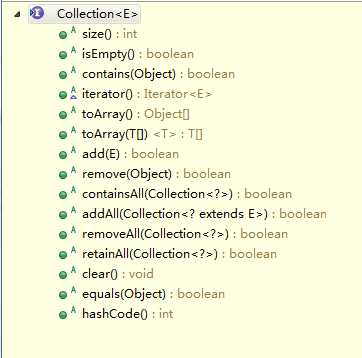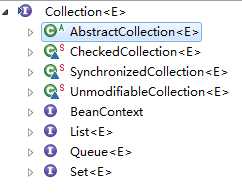标签:
Ref:http://blog.csdn.net/liulin_good/article/details/6213815
http://www.cnblogs.com/averey/p/4306166.html
一、java.util.Iterator<E>接口
迭代器

1 package java.util; 2 3 public interface Iterator<E>{ 4 // Return true iteration has more elements 5 boolean hasNext(); 6 7 // Return the next element in the iteration 8 E next(); 9 10 // Remove the last element returned by this iterator. This method can be called only once per call to next 11 void remove(); 12 }
二、java.util.Collection接口
继承java.lang.Iterable接口,包含iterator()方法返回Iterator<T>

1 package java.util; 2 3 public interface Collection<E> extends Iterable<E>{ 4 5 int size(); 6 7 boolean isEmpty(); 8 9 boolean contains(Object o); 10 11 Iterator<E> iterator(); 12 13 Object[] toArray(); 14 15 // <T>:申明T为泛型。参考:http://www.zhihu.com/question/31967519 16 <T> T[] toArray(T[] a); 17 18 boolean add(E e); 19 20 boolean remove(Object o); 21 22 //Collection<?>:未知Collection,该Collection的元素类型可以匹配任意类型 23 boolean containsAll(Collection<?> c); 24 25 boolean addAll(Collection<? extends E> c); 26 27 boolean removeAll(Collection<?> c); 28 29 //保留该集合中在目标集合中的元素 30 boolean retainAll(Collection<?> c); 31 32 void clear(); 33 34 boolean equals(Object o); 35 36 int hashCode() 37 }

三、Collection类型层次

标签:
原文地址:http://www.cnblogs.com/iszer/p/5285009.html